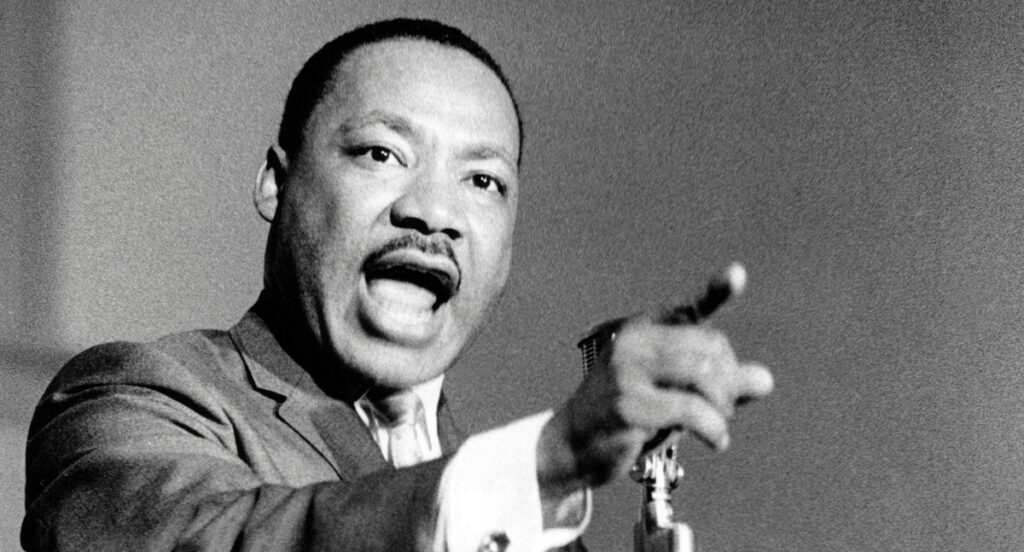
Podcast: Play in new window | Download
Subscribe: Spotify | Amazon Music | Youtube Music | RSS
“Darkness cannot drive out darkness, only light can do that. Hate cannot drive out hate, only love can do that.” – Martin Luther King Jr.
Martin Luther King Jr was a minister and civil rights activist who spoke out against racial segregation in the United States of America. He led the Montgomery bus boycott in 1955 and became a champion of civil rights through his charismatic personality and inspirational speeches. He won the Nobel Peace Prize in 1964, four years before he was assassinated in Memphis Tennessee at the age of only 39 and was posthumously awarded the Presidential Medal of Freedom and the Congressional Gold Medal.
He was born Michael King Jr. on 15 January 1929 in Atlanta, Georgia, USA and was the middle child of three born to Reverend Michael King Sr. and his wife Alberta. Michael King Sr. was the son of sharecroppers who left his parents’ farm as a teenager, walking to Atlanta in search of a high school education before entering Morehouse College where he studied to become a minister. In time he became pastor of the Ebenezer Baptist Church and worked hard to successfully increase its attendance.
In 1934, the church sent King Sr. on a tour of Europe, Africa and the Holy Land, culminating in a meeting of the Baptist World Alliance (BWA) in Berlin, Germany. Whilst there, he observed first-hand the rise of Nazism which prompted the BWA to issue a statement which read, “This congress deplores and condemns as a violation of the law of God the Heavenly Father, all racial animosity, and every form of oppression or unfair discrimination toward the Jews, toward coloured people, or toward subject races in any part of the world.”
As a follower of the teachings of Martin Luther, when he returned home, he stopped referring to himself as Michael King Sr, preferring instead to be called Martin Luther King Sr. His son was also from that point forward to be referred to as Martin Luther King Jr.
King Jr. had a strict and religious upbringing. Stories would be told from the bible, but whippings were also handed out for the slightest of offences, with the children sometimes being required to whip each other.
At the age of six, King Jr. started attending Younge Street Elementary School, which was a school for black children, whilst his close friend from across the street went to a whites-only school. Soon after, his friend’s parents stopped the children from playing together and when King told his father, he sat him down and proceeding to tell him of slavery and racism in America.
At the age of 13, King Jr. started attending the Booker T. Washington High School, which was the only one in Atlanta for African American students. He won an oratorical contest in his junior year with a speech that stated, “black America still wears chains. The finest negro is at the mercy of the meanest white man”.
When he was 15 years old he passed the entrance exam to Morehouse College and played football there until in 1947 at the age of 18 he declared that he needed to address an inner urge to serve humanity, and decided to enter the ministry, studying under the Baptist minister Benjamin Mays. He graduated in 1948 with a BA in sociology.
The next step was for him to attend Crozer Theological Seminary from where he graduated with a Batchelor of Divinity degree in 1951 before beginning his doctoral studies in systematic theology at Boston University whilst also attending philosophy classes at Harvard in 1952 and 1953. Martin Luther King Jr. received his Ph.D on 5 June 1955, becoming Doctor King. It was while he was studying at Boston that Doctor King met Coretta Scott after being introduced by a mutual friend and the couple were married on 18 June 1953, and went on to have four children; Yolanda, Martin Luther King III, Dexter, and Bernice.
In 1955, two incidents would lead Martin Luther King Jr. to become involved in and ultimately lead what would become known as the Montgomery bus boycott. The two incidents in question were when in March of that year Claudette Colvin refused to give up her bus seat in favour of a white man and then in December, Rosa Parks did the same. Both acts were in violation of the Jim Crow laws which had enforced racial segregation in the Southern United States. The boycott lasted for 385 days and at one point a bomb was thrown through the window of Doctor King’s house as retribution. However, the boycott was successful with a court ruling that racial segregation on Montgomery buses should end. Doctor King became a nationally recognised figure overnight.
Various campaigns against racial segregation followed, such as in Albany in 1961, Birmingham in 1963, St. Augustine, Florida in 1964, and in Selma, Alabama and New York in the same year.
In 1963, King was one of the leaders of the six big civil rights organisations that marched on Washington D.C. Initially, President John F. Kennedy was against it as he thought it might detract from the civil rights legislation that he was trying to push through, but when it became clear that the march was going to go ahead anyway, he threw his support behind it. The march was a resounding success leading to the passage of the Civil Rights Act of 1964 with one of its legacies being Martin Luther King’s “I Have a Dream” speech, which has since come to be regarded as one of the finest in American history.
King continued to have successes throughout the South for the next couple of years although not all of them would be as peaceful as he would like. In 1965 an attempt was made to march from Selma to Montgomery, but this had to be abandoned due to the mob and police violence enacted against the marchers. This episode would come to be known as Bloody Sunday.
Martin Luther King Jr. had always been an advocate of non-violence advocating civil disobedience instead, taking his inspiration from Mahatma Gandhi. He was also opposed to America’s involvement in the Vietnam war. He participated in an anti-war march in 1967 and on 13 January 1968 he called for a large march on Washington against what he called “one of history’s most cruel and senseless wars”.
Two months later, King was in Memphis, Tennessee, supporting the sanitary public works employees who had been striking since 12 March for higher wages and improved treatment. On 3 April he delivered his famous “I’ve Been to the Mountaintop” speech at Mason Temple in which many believe he prophesised his own death.
As was usual when he was in Memphis, he stayed in room 306 of the Lorraine Motel where at 6.01pm on the night of 4 April 1968, whilst he was stood on the second floor balcony outside his room, Martin Luther King Jr. was shot by a lone gunman called James Earl Ray. Doctor King was taken to hospital where he underwent emergency surgery, but he died at 7.05pm. He was 39 years old.
Podcast: Play in new window | Download
Subscribe: Spotify | Amazon Music | Youtube Music | RSS




